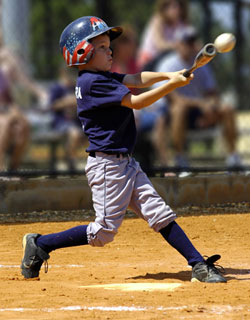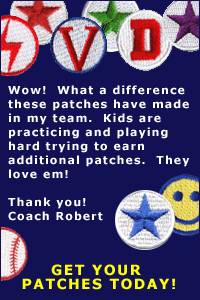Baseball Hitting
This section of the website is dedicated to hitting and coaching hitters.
 It's said that hitting a baseball is the most difficult skill in all sports; not surprisingly, giving hitting instruction is also one of the most difficult skills a coach has to learn. Teaching baseball hitting is difficult because every player is different in the many combination of skills required to hit a baseball. While teaching infield or outfield skills, you can run the same drills and teach everyone uniformly. However, with hitting, each player will require his own set of instructions and hitting drills to maximize his/her understanding and potential. Like hitting itself, teaching hitting will require a lot of hard work and study. Too many coaches want to apply a cookie cutter approach to hitting instruction. That approach will not work since every player has his own style at the plate. Watch a single Major League Baseball game and you'll see a wide variety of hitting styles and approaches. As a coach you're going to have to be able to differentiate the aspects of hitting for each player and apply changes to help that particular aspect of the swing.
It's said that hitting a baseball is the most difficult skill in all sports; not surprisingly, giving hitting instruction is also one of the most difficult skills a coach has to learn. Teaching baseball hitting is difficult because every player is different in the many combination of skills required to hit a baseball. While teaching infield or outfield skills, you can run the same drills and teach everyone uniformly. However, with hitting, each player will require his own set of instructions and hitting drills to maximize his/her understanding and potential. Like hitting itself, teaching hitting will require a lot of hard work and study. Too many coaches want to apply a cookie cutter approach to hitting instruction. That approach will not work since every player has his own style at the plate. Watch a single Major League Baseball game and you'll see a wide variety of hitting styles and approaches. As a coach you're going to have to be able to differentiate the aspects of hitting for each player and apply changes to help that particular aspect of the swing.
Avoid drastic changes...make small changes instead
The first piece of advice would be to avoid drastic changes in a player's hitting style until you know what that player can and can't do. Except for very young players, they're hitting the way they are for a reason. If you change them right away, you won't know why they had adopted the style they had.
For example: I saw a coach who in the first practice noticed that a player was hitting with a very open stance. The player was struggling during batting practice to make contact. The coach believed that a square or slightly closed stance was better. Immediately he changed the player's stance. What he didn't know and didn't take time to find out was the player's dominant eye was his right eye. He had developed an open stance over time in order to be able to see the ball better. Now there are many great players at all levels that hit with an open stance, but for some reason this coach wanted to mold everyone into the stance he believed to be the best. This particular hitter couldn't hit well with that stance and struggled for the early part of the season before he finally abandoned the coach's instructions and went back to an open stance.
So what are the morals of the story? Here are a few.
Be Open Minded When You Work on Hitting With a Player
Why would a player like that stance? Not sure, ask him.
I could field as long as I can remember, but hitting has been a struggle all my life.
~ Brooks Robinson
Take Your Time As You Work On Hitting With A Player
Many times coaches feel like they have to have the answer immediately. When a player struggles, the coach may feel the need to correct the problem. It can't always be done; actually, it almost never can be done as quickly as the coach would like.
Analyze the problem. Assume that what you perceive as the problem isn't the problem. What else is the player doing that could cause the problem? In the example above, the player may not have been tracking the ball, may have been too far away from the plate, may have been just too rusty.
This is a good time to talk about video taping your hitters. If you don't videotape your hitters, you're missing out on one of the best ways to figure out how to turn them into good hitters. Tape hitters, analyze the tapes, and then review the tape with the player. Often players can't feel that they are doing something wrong. You may tell them that they are dropping their hands below the waist before the swing, but they won't feel it. Videotapes don't lie. You can show them exactly what their swing looks like and come up with some drills to make modifications.
Before you get worried that you have to come up with different strategies for each hitter, there is some good news. There are certain fundamentals that are shared by good hitters. A coach often falls into the trap of being too concerned with what a hitter is doing before the ball is even pitched and not enough attention to what the hitter is doing after the ball is released from the pitchers hand.
When you learn the fundamentals that are shared by good hitters, you'll be able to take that videotape of your hitters and make very small changes necessary to turn a hitter around. Don't try to change everything at once. Make small adjustments and have the player practice that new skill until it's natural. Then move on.
Help players develop the mental side of hitting
Many coaches only focus on the physical side of hitting. While that's important, it's just as important to develop the mental side of a hitter. Hitters have to go up to the plate knowing they can be successful. It's the coaches job to try instill that positive attitude in the player. Work with a player on having a positive thought process from the time they step into the batter's box until they are running to the base. They need to think up at the plate and focus on each pitch believing this will be the pitch. That thought process won't come naturally for most players, you'll need to work to instill it.
Hitting is fifty percent above the shoulders
~ Ted Williams
In the next few pages, we'll cover the fundamentals of good hitting. Often we'll give a variety of different methods. Hopefully this will provide you with the necessary information to help you help your players.
Baseball Hitting Drills
There are many good hitting drills that you can use in our baseball drills section.
Most Recent Blog Posts
Working With Players on Focusing on the Correct Part of the Baseball when Hitting (October 15 2016)
Getting More Accurate Throws From Your Team (April 5 2016)
I found your website by "googling" for a baseball website to give me some advice about helping my grandson with basic skills. I have been reading with great interest until my eyes get "bleary". Good stuff. Really good stuff. You are providing the kind of advice I was looking for and you do a very thorough job of it. Keep up the great work.
A big fan,
- Stephen B.








